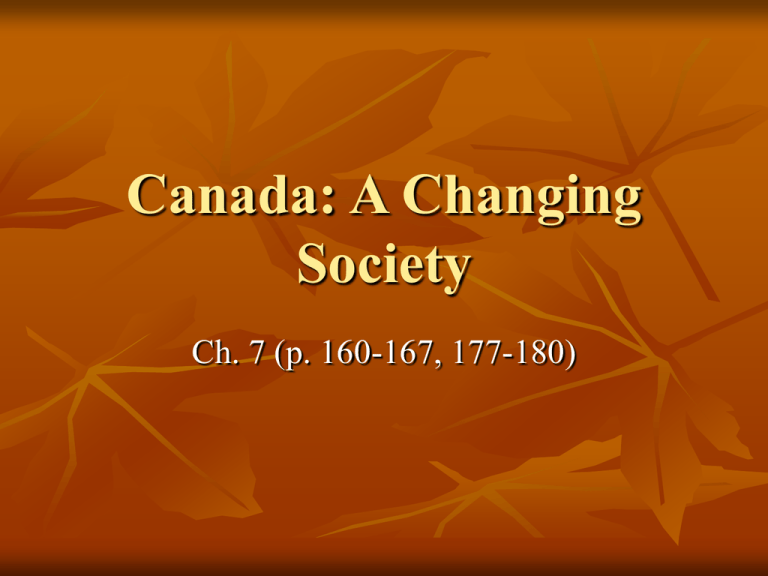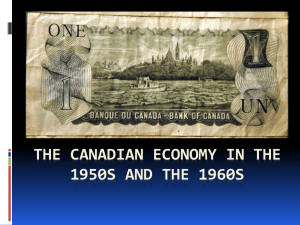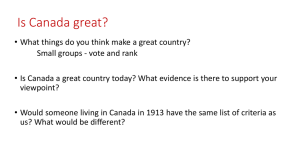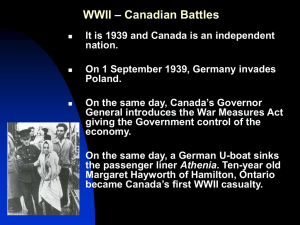Canada: A Changing Society
advertisement

Canada: A Changing Society Ch. 7 (p. 160-167, 177-180) Canada After WWII Returning veterans helped by government programs Veterans and wave of immigrants leads to increased demand for housing Rise of suburbs (housing developments and communities outside of city centres) Suburban Values Traditional family life Stay-at-home mom, working dad, 2+ kids (nuclear family) Increase in the birth-rate 1946-1961 (ie. “baby boom”) Suburbia Suburban Nuclear Family Canada After WWII Age of the Automobile Cars needed by families in suburbs, commute to work Small neighbourhood stores replaced by fewer large supermarkets and department stores, shopping malls Poor safety: seat belts rare, drunk-driving common Consumer Society Rise in advertising, especially on television Economy booming, Canadians have money to spend New high-tech gadgets, appliances, toys, etc. Conspicuous consumption “keeping up with the Joneses” Advertising Canada After WWII Teen Culture and the Youth Movement Before WWII, the average Canadian was out of school by grade 8 Need to make money for family, needed to fight in wars Baby boomers stay in school much longer, university Economy booming, not needed as soldiers A lot of free time, spending money from part-time jobs Become target for businesses, advertising Teens create their own culture Fashion, slang, music, movies, etc. Canada After WWII Teen Culture and the Youth Movement Baby boomers rebel against parents/adults Rock ‘n’ roll culture in 1950s, becomes accepted by adults by mid-1960s Hippie culture in mid-1960s and early-1970s “youthquake” – long hair, psychedelic stuff, sexual promiscuity, drug experimentation, anti-consumerism Mass political protests and demonstrations, politicians take note Voting age lowered from 21 to 18 “Trudeaumania” – wave of popularity that swept Pierre Trudeau into office, treated like a rock star Why?: informal, flashy, scandalous, bachelor until 1971 By 1980s, baby boomers growing up, many have careers and families, “settled down”, protest movement fades away Teen Culture Teen Culture Trudeaumania Protecting Canadian Culture Canadians, especially youths, increasingly influenced by American culture after WWII Movies, TV, music, celebrities, etc. Adults and government increasingly concerned Massey Commission (1949) Purpose: investigate the state of Canadian culture 1951: reported that Canadian culture should be protected from American influences National Film Board (NFB) should be strengthened Makes documentary films by Canadians and/or about Canada Federal government should help fund the arts Protecting Canadian Culture Protecting Canadian Culture Canada Council (1957) funded by federal government gives grants to artists and organizations to strengthen Canadian culture Canadian Broadcasting Corporation (CBC) Broadcast on radio since 1936 Response to influence of American culture pre-WWII 1952: establishes television stations, broadcasts Canadian content across country Protecting Canadian Culture Protecting Canadian Culture Canadian Radio-television and Telecommunications Commission (CRTC) Established in 1968 Regulates Canadian broadcasting (TV and radio) Controls how much foreign programming can be broadcast on television and radio in Canada Requires certain amount of Canadian programming on TV and radio







